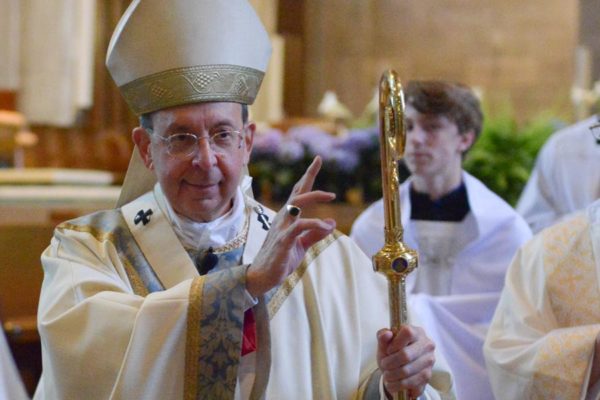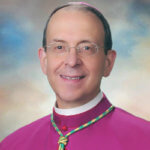2nd Sunday in Ordinary Time
“Life Is Beautiful” Mass
St. Joseph, Fullerton
Jan. 19, 2020
Last Sunday, my mother celebrated her 100th birthday and my parents celebrated their 73rd wedding anniversary. At this point in their lives, Mom and Dad live in a nursing facility but we were able to bring them to their parish church for Mass, and afterwards, we had a luncheon in their honor in the parish hall. Mom and Dad were happy to be surrounded by family and friends, even if they found it all just a little overwhelming. During lunch, a woman whom Mom had known for many years said to her, “Why, Mrs. Lori, you look wonderful. You don’t look a day over 80!”
Later that day, when my parents had returned to the nursing facility, Mom and Dad were tired but very happy. Still wound up from the event, Mom wanted to talk. She spoke about her parents and how much she still loves them. She thanked them for the gift of life and for raising her in the Catholic faith. She talked about being married to Dad for nearly three-quarters of a century, and the gift of the three sons she and Dad welcomed into the world, and how she and Dad tried to make our home happy, secure, full of faith and love. She spoke about the challenges she and Dad faced, and the love they continue to share. Mom gave thanks to the Lord and to the Blessed Mother for all these blessings.
All this was more than a trip down memory lane. Without using these words, Mom was really saying to me, “life is beautiful” – In effect, she preached a “life is beautiful” homily to me, a homily she and Dad have written with their lives. Today I thank them for teaching me that “life is beautiful”.
An ‘Ascending’ Appreciation for the Beauty of Life
Dear friends: let us reflect further on the beauty of human life. When the Psalmist exalts, “I will praise you, for I am fearfully, wonderfully made” (Psalm 139:4), he is giving voice to the praise and gratitude we should all feel for the gift and beauty of human life at all its stages – from the first moment of conception until the moment of natural death.
And, as science and technology continue to unlock the secrets of our humanity, we recognize, as people of faith and reason, that those secrets, those wonders, were there all along. We also recognize that, no matter how carefully we look, we will never unlock all the secrets, all the wonders, of our human nature. It stands to reason that all these intricacies of our human life aren’t an accident, nor simply the culmination of a blind and unguided process. Simply put, God is the author of our humanity and God knew what he was doing!
But the beauty and mystery of our humanity does not lie merely in the size of our cranium or in the development of opposing thumbs. What no researcher will ever comprehend are the depths of the human heart. For, as we read in the Old Testament Book of Judith, “You cannot plumb the depths of the human heart or grasp the workings of the human mind . . .” (Judith 8:14). Or as the Prophet Jeremiah warned, “More tortuous than anything is the human heart, beyond remedy” (Jer. 17:9). Now, that last quotation might not seem to support the thesis that “life is beautiful”. It says we are wounded by sin; our hearts are complicated; and our reason is clouded. Nonetheless, the voice of God still echoes in the depths of our hearts, summoning us to embrace what it morally right and true and good (cf. GS, 16), and calling us to friendship with himself and eternal life and joy with the saints. And at the heart of our humanity is something so beautiful that not even sin could extinguish it, namely, a spark of divinity, an immortal soul, a longing for eternal life and love, a desire for God. Yes, we are made in God’s image. For all our foibles, life is indeed beautiful.
“Behold, the Lamb of God”
It is Jesus who ultimately reveals the beauty and worth of human life. In today’s Gospel, John the Baptist sees Jesus coming towards him and says, “Behold, the Lamb of God, who takes away the sins of the world” (Jn. 1:29). John also testified that he saw the Holy Spirit descend upon Jesus (v. 33), and proclaimed him truly to be “the Son of God” (v. 34). What light does this powerful Gospel passage shed on the beauty of human life?
Perhaps it is this: our humanity and each human life is utterly valuable in God’s eyes. So valuable, in fact, that despite the deformity and enormity of human sinfulness, God the Father sent his Eternal Son into the world to assume our human nature, to become one of us – with a human body, mind, and will – and it was through our humanity – our flesh, our blood, our mind, and our heart – that the Incarnate Savior brought about our redemption – the forgiveness of our sins and the restoration of our wounded human dignity. When John says, “Behold the Lamb of God who takes away the sins of the world,” he identifies Jesus as the Paschal Lamb, “the lamb led to slaughter” (cf. Is. 53:7-9; AA 8:32), who would open for us a pathway, not merely through the Red Sea, but a pathway that leads from sin to grace and from death to eternal life, to complete reconciliation with God and one another. When John the Baptist says that Jesus ‘existed before he did’ (John 1:31), John identifies Jesus as the Eternal Word, as the Eternal Son of God, upon whom the Holy Spirit rests – Jesus the Christ – the Anointed One, who would pour out the Holy Spirit upon the whole of humanity.
Let us take this in, we who have been baptized by water and the Holy Spirit; we who receive the Lamb of God in Holy Communion; we who are reconciled and forgiven in the Sacrament of Penance; we, who have been “sanctified and called to be holy” (1 Cor. 1:3) – How deeply God loves us and how deeply he cherishes our humanity! What beauty God sees in each human life, so much so, that he surrendered to us his only Son as our Redeemer. If God has loved us so, and if his love has found a home in our hearts, then we should have a new capacity to see the beauty of our humanity, the dignity and worth of every human life … the tiny, defenseless baby in the womb, exhibiting all the marks of our humanity; those who have grown frail with advancing years; the chronically and terminally ill; the homeless, the unemployed, and victims of violence on our streets; the incarcerated; those who have been uprooted from their homelands… No one is a mere statistic. No one is a mere condition. Every human life has worth and beauty in God’s eyes, and if that is so, every human life must have worth and beauty in our eyes.
Nor is it enough merely to see the beauty of humanity. We must continue to heed the call of St. John Paul II to build a culture of life: a culture in which the innocent and defenseless are protected from harm; a culture that rejects racism and xenophobia in all its forms; a culture in which the young are formed in strong and loving homes; a culture that rejects conditions that undermine human dignity, especially lack of economic and educational opportunity; a culture that refuses to accept violence as an acceptable reality of life, especially in our most impoverished communities; a culture which never decides that any life is not worth living. That is why our voices must be heard in the halls of political power. That is why we must continue to support pro-life pregnancy centers, morally sound hospice care and an array of church-run charitable and social programs that seek to address the daily assaults on the beauty and dignity of human life. That is why we must support our Catholic schools and formation programs that are so important in forming new generations of believers and citizens.
If, in the power and grace of the Holy Spirit, we join hands throughout the Archdiocese in building a culture of life, then will the beauty of human life become more compellingly evident to all, to the glory of God, the author and lover of our humanity. And may God bless us and keep us always in his love!


